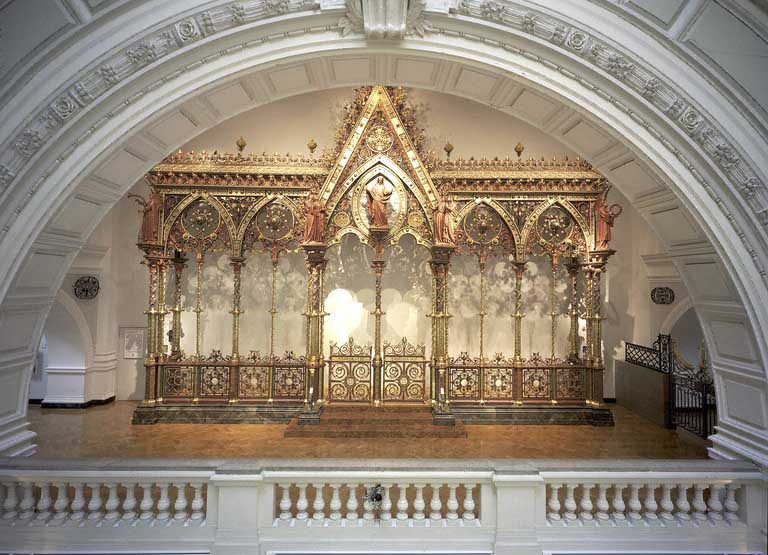Hereford Screen on:
[Wikipedia]
[Google]
[Amazon]
 The Hereford Screen is a great choir screen designed by Sir
The Hereford Screen is a great choir screen designed by Sir
 The Hereford Screen is a great choir screen designed by Sir
The Hereford Screen is a great choir screen designed by Sir George Gilbert Scott
Sir George Gilbert Scott (13 July 1811 – 27 March 1878), largely known as Sir Gilbert Scott, was a prolific English Gothic Revival architect, chiefly associated with the design, building and renovation of churches and cathedrals, although he ...
(1811–1878) and made by Coventry metalworking firm Skidmore
Skidmore may refer to:
Places United States
* Skidmore, Kansas
* Skidmore, Maryland
* Skidmore, Michigan, an unincorporated community
* Skidmore, Missouri, a city
* Skidmore, Texas
* Skidmore, West Virginia
* Skidmore Fountain, a public fountai ...
& Co. for Hereford Cathedral
Hereford Cathedral, formally the , is a Church of England cathedral in Hereford, England. It is the seat of the bishop of Hereford and the principal church of the diocese of Hereford. The cathedral is a grade I listed building.
A place of wors ...
, England in 1862. It was one of the Gothic Revival
Gothic Revival (also referred to as Victorian Gothic or neo-Gothic) is an Architectural style, architectural movement that after a gradual build-up beginning in the second half of the 17th century became a widespread movement in the first half ...
works in iron
Iron is a chemical element; it has symbol Fe () and atomic number 26. It is a metal that belongs to the first transition series and group 8 of the periodic table. It is, by mass, the most common element on Earth, forming much of Earth's o ...
of the nineteenth century. When it was unveiled at the 1862 International Exhibition
The International Exhibition of 1862, officially the London International Exhibition of Industry and Art, also known as the Great London Exposition, was a world's fair held from 1 May to 1 November 1862 in South Kensington, London, England. Th ...
it was hailed as the "grandest and most triumphant achievement of modern architectural art".
Weighing over eight tonnes, the screen is a mixture of wrought and cast iron, brass
Brass is an alloy of copper and zinc, in proportions which can be varied to achieve different colours and mechanical, electrical, acoustic and chemical properties, but copper typically has the larger proportion, generally copper and zinc. I ...
, copper
Copper is a chemical element; it has symbol Cu (from Latin ) and atomic number 29. It is a soft, malleable, and ductile metal with very high thermal and electrical conductivity. A freshly exposed surface of pure copper has a pinkish-orang ...
, semi-precious stones, and mosaics
A mosaic () is a pattern or image made of small regular or irregular pieces of colored stone, glass or ceramic, held in place by plaster/Mortar (masonry), mortar, and covering a surface. Mosaics are often used as floor and wall decoration, and ...
, supporting electroformed statues of Christ
Jesus ( AD 30 or 33), also referred to as Jesus Christ, Jesus of Nazareth, and many other names and titles, was a 1st-century Jewish preacher and religious leader. He is the Jesus in Christianity, central figure of Christianity, the M ...
and attendant angels
An angel is a spiritual (without a physical body), heavenly, or supernatural being, usually humanoid with bird-like wings, often depicted as a messenger or intermediary between God (the transcendent) and humanity (the profane) in variou ...
. In 1967 the screen was dismantled as it was no longer considered fashionable. It was stored in wooden packing cases by Coventry's Herbert Museum waiting for it to be re-erected in a new museum dedicated to Coventry's Industrial past, but funds were never available, (the only item ever being unpacked was the angel with the harp). So Coventry passed over the custodianship to the Victoria and Albert Museum
The Victoria and Albert Museum (abbreviated V&A) in London is the world's largest museum of applied arts, decorative arts and design, housing a permanent collection of over 2.8 million objects. It was founded in 1852 and named after Queen ...
in 1984, but it was in very poor condition. In 2001, after a successful campaign to fund the largest conservation project ever undertaken by the Museum, the fully restored metal masterpiece was erected in pride of place, overlooking the main entrance.
Bibliography
*External links
* {{cite web , publisher=Victoria and Albert Museum
The Victoria and Albert Museum (abbreviated V&A) in London is the world's largest museum of applied arts, decorative arts and design, housing a permanent collection of over 2.8 million objects. It was founded in 1852 and named after Queen ...
, url=http://www.vam.ac.uk/collections/metalwork/metalwork_stories/hereford/index.html
, title=The Hereford Screen
, work=Metalwork
, accessdate=2008-08-26
, url-status=dead
, archiveurl=https://web.archive.org/web/20080401101330/http://www.vam.ac.uk/collections/metalwork/metalwork_stories/hereford/index.html
, archivedate=2008-04-01
Collection of the Victoria and Albert Museum
Artworks in metal
George Gilbert Scott buildings and structures